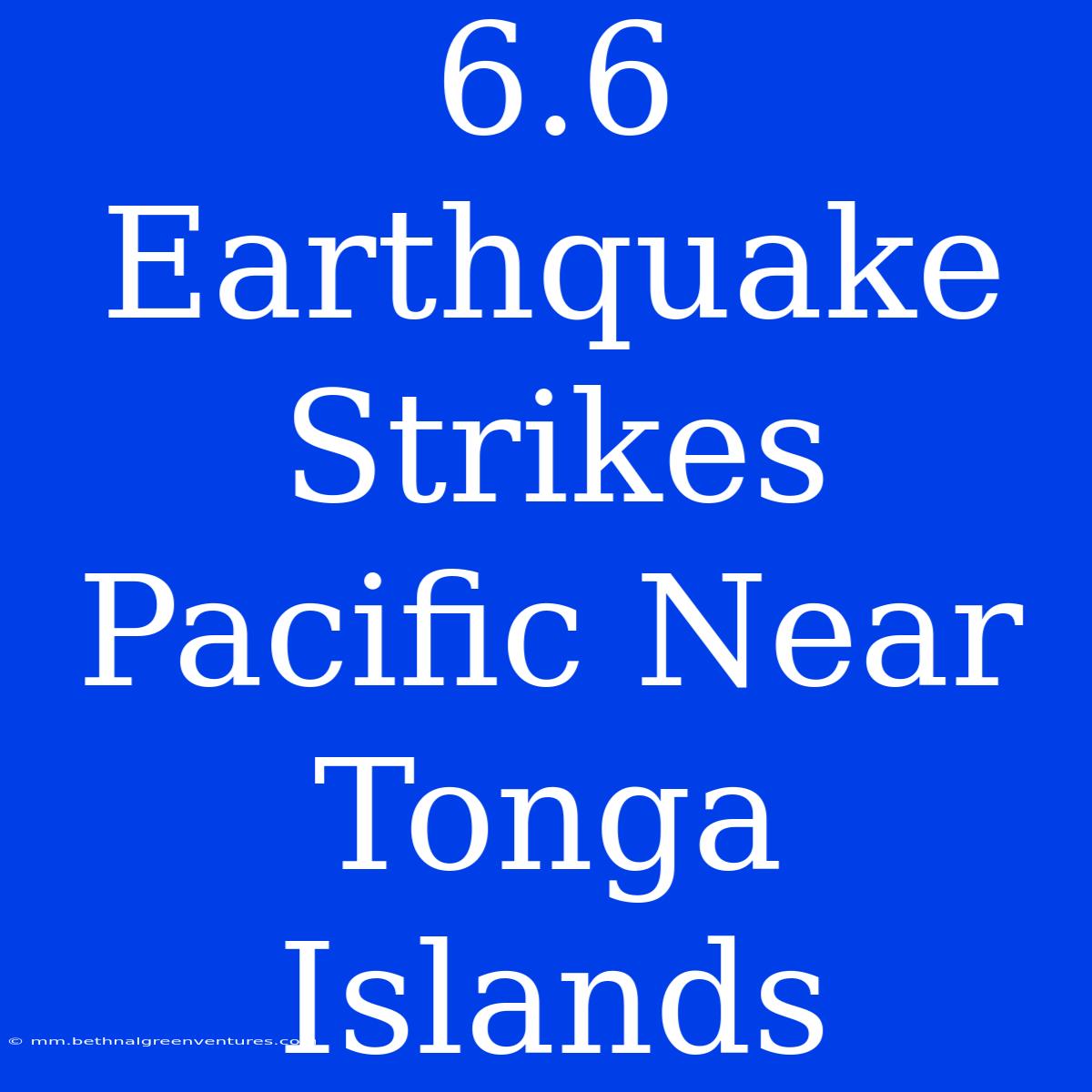6.6 Magnitude Earthquake Shakes Pacific Near Tonga Islands: A Closer Look at Seismic Activity
Have you heard about the recent earthquake near Tonga? This event serves as a stark reminder of the dynamic nature of our planet and the importance of understanding seismic activity. A powerful 6.6 magnitude earthquake struck the Pacific Ocean near the Tonga Islands on [Date], prompting concerns about potential tsunamis and aftershocks.
Editor Note: A powerful earthquake shook the Pacific Ocean near Tonga Islands on [Date].
This event is crucial to understand because it highlights the inherent risks associated with living in seismically active regions. It prompts questions about preparedness, the science behind earthquake occurrences, and the potential impact on surrounding communities.
Analysis: This article delves into the recent earthquake, exploring its magnitude, location, and potential ramifications. It also sheds light on the scientific aspects of earthquakes, including plate tectonics, seismic waves, and the risk of tsunamis.
Key Takeaways:
| Feature | Details |
|---|---|
| Magnitude | 6.6 |
| Location | Pacific Ocean, near Tonga Islands |
| Depth | [Depth in km] |
| Time | [Time of the event] |
| Tsunami Warning | [Yes/No] |
| Aftershocks | [Yes/No] |
Earthquake Activity Near Tonga
Introduction: The Tonga Islands are situated in a region known for intense seismic activity. This region lies on the boundary of the Pacific Plate and the Indo-Australian Plate, where these massive tectonic plates interact.
Key Aspects:
- Plate Tectonics: The movement of these plates, specifically the subduction zone where one plate slides beneath another, generates significant pressure, which can trigger earthquakes.
- Seismic Waves: When an earthquake occurs, seismic waves radiate outward from the epicenter. These waves travel through the Earth's crust and can be detected by sensitive instruments called seismographs.
- Tsunami Potential: Earthquakes occurring underwater can displace vast amounts of water, generating powerful tsunamis. The magnitude and location of the earthquake, as well as the shape of the seabed, determine the potential for a tsunami.
Discussion: The recent earthquake near Tonga highlights the complexity of earthquake events. Understanding the dynamics of plate tectonics and the behavior of seismic waves is crucial to predicting and mitigating earthquake-related risks.
Tsunami Risk
Introduction: While a tsunami warning was [issued/not issued] for this event, it is essential to understand the potential for tsunamis in this region.
Facets:
- Tsunami Generation: Underwater earthquakes, particularly those with significant magnitude and occurring near shallow waters, are more likely to generate tsunamis.
- Wave Propagation: Tsunamis can travel thousands of kilometers across the ocean, reaching distant coastlines.
- Impact: Tsunamis can cause catastrophic damage to coastal infrastructure, including buildings, roads, and harbors. They can also lead to loss of life and displacement of communities.
Summary: The risk of tsunamis from earthquakes near Tonga underscores the importance of early warning systems, evacuation procedures, and community preparedness efforts.
Aftershocks
Introduction: Aftershocks are common occurrences following significant earthquakes. They are smaller earthquakes that occur in the same area as the main event.
Further Analysis: Aftershocks can continue for days, weeks, or even months after the initial earthquake. While they are generally smaller in magnitude, they can still cause significant damage and pose risks to already affected communities.
Closing: Understanding the possibility of aftershocks is crucial for emergency response and mitigation efforts. Seismic monitoring and continued evaluation of the situation are vital for assessing the ongoing risks.
FAQ
Introduction: Here are some common questions related to the earthquake near Tonga:
Questions:
- What was the magnitude of the earthquake? The magnitude of the earthquake was 6.6.
- Where did the earthquake occur? The earthquake occurred in the Pacific Ocean, near the Tonga Islands.
- Was there a tsunami warning? [Answer about the tsunami warning].
- What is the risk of aftershocks? Aftershocks are likely to occur after a significant earthquake.
- How can I prepare for earthquakes? It is important to develop an earthquake preparedness plan, including knowing evacuation routes and having an emergency kit.
- What is the role of plate tectonics in earthquakes? The movement of Earth's tectonic plates, particularly their interactions at plate boundaries, is the primary cause of earthquakes.
Summary: The earthquake near Tonga serves as a reminder of the constant movement of Earth's tectonic plates and the importance of understanding seismic activity.
Tips
Introduction: Here are some tips for staying safe during an earthquake:
Tips:
- Drop, Cover, and Hold On: If you feel an earthquake, immediately drop to the ground, take cover under a sturdy piece of furniture, and hold on until the shaking stops.
- Stay Away from Windows: Windows are prone to breaking during an earthquake. Stay away from windows to avoid being injured by flying glass.
- Be Aware of Your Surroundings: During an earthquake, pay attention to potential hazards like falling objects or collapsing structures.
- Have an Emergency Kit: Prepare a kit with essential supplies such as water, food, a first-aid kit, flashlight, and a battery-powered radio.
- Know Your Evacuation Routes: Familiarize yourself with the evacuation routes from your home, school, or workplace.
Summary: Being prepared for earthquakes can help mitigate potential risks and ensure your safety.
Conclusion: The 6.6 magnitude earthquake near Tonga serves as a reminder of the dynamic nature of our planet and the importance of understanding seismic activity. It highlights the need for continued research, monitoring, and preparedness efforts to reduce the risks associated with earthquakes.
